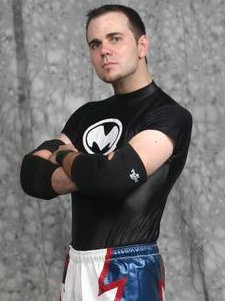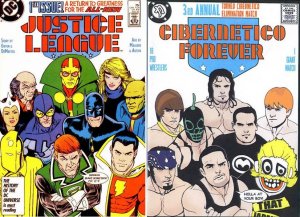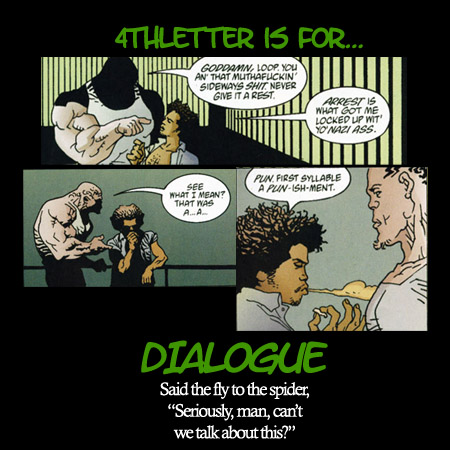G. To read Alan Moore’s work, it’s so beautiful and architectural and everything about it is great, but for me, that fire of creativity isn’t there in it, and I’m not fooled by it. I read Promethea last night, and I thought, “This is Doom Patrol, I don’t care, there’s nothing new for there for me here, but it’s so beautifully constructed, I wish I could do this kind of thing…
S. …immaculate objects…
G. …yes. It lacks the transcendental, it lacks the soul. And even last night, I was talking to Warren, The Authority’s like Justice League, but to me, what I find in that is this voice coming out, that to me, Warren’s got this voice of this new whatever generation it is that’s coming up where there’s all this violence and black humour, and that’s why I love it, because it is a thing with fire coming out of it. I don’t get that with Moore’s stuff, I just get this brilliance.
–from an interview with Grant Morrison conducted by Spiros Xenos in 1999
My secret shame as a comics fan is that I’m not an Alan Moore fan.
I’ve spent a couple days trying to write this post, actually. It veered a little too close to being a Moore vs Morrison whinefest. I’ll try to hit you with the bullet points.
Let’s discuss.
I’ve read a few Moore books that I liked. Watchmen (I own the Absolute!), V for Vendetta, Top Ten, and LXG are all good stuff. They’re technically impressive and Moore has an incredible grasp on the craft of comics-making. He may be the best technical writer ever, and he’s been gifted to work with some stellar artists at the same time. Dave Gibbons, Kevin O’Neill, JH Williams III, Gene Ha and Zander Cannon, all of these guys are ridiculously good.
However, I just can’t get into the majority of Moore’s work. Promethea leaves me flat, Lost Girls turns me off, and the majority of his America’s Best Comics were really sort of boring.
I think my issue with it is, as Morrison kind of describes above, it’s lacking in heart. It feels empty. Top Ten is the best superhero pastiche/homage since Planetary, but it all feels very by the numbers. Here’s the Fantastic Four analogues, here’s the DC characters, and so on. There’s no sense of the “Gee whiz, this is cool!” that I get from other comics writers.
I think that this is because Moore’s work is so perfectly constructed. You can tell the care that goes into his pages. You can tell that he’s thought a lot about it. However, because of that construction, all of his work feels very calculated. It doesn’t feel fun at all. Not to say that he hasn’t done some fun comics, as a handful of issues of Tom Strong were really very fun, along with that issue of Mr. Majestic he did years ago with the Dyson Spheres, I believe. But, my overall impression of Moore’s work is that it is all very serious and important and literary, capital letters optional.
I feel like I can see the man behind the curtain in too much of his work. It’s lacking in spontaneity. It’s too perfect. It’s there to be held up and admired, like art, rather than devoured, like pop culture.
(I’m an English major, honest. I’m not a literiluddite, I swear!)
Have you guys seen the proposal for Alan Moore’s Twilight of the Superheroes? It’s a DKR-style tale of superheroes gone wrong and fascist and their grisly end. Check the internet. It’s hailed as being an incredible tale, full of vim, vigor, and clever plot twists.
I read this proposal and was completely repulsed. Billy Batson as a leather sex midget? J’onn J’onnz as a murderer? John Constantine being so stubborn that he’d doom himself to a life of loneliness out of spite? Again, technically and craft-wise, it’s wonderfully constructed. It’s just lacking that heart and charm that I like from my comics.
Reading Moore is kind of like reading the classics. It’s very, very good, but it isn’t really very fun. I love Albert Camus, Voltaire, and Faulkner. I’m okay with Hemmingway, but you’ll rarely catch me reading them just because. Alan Moore’s work is a lot like that for me.
On the other side is Grant Morrison, relentless optimist and imperfect creator. His work has a snap and just earnestness about it that I don’t get from Moore. Even when he screws up or falls short of his goal, most especially in Batman 663, you just get this sense that he’s trying to give you that same feeling of “Gee whiz!” with his work. All-Star Superman illustrates this really well. He loves the Silver Age Superman and, when combined with a talent on the level of Quitely, you can tell.
His reach can easily exceed his grasp and he sometimes falls victim to scripting anticlimaxes, but he’s really very earnest about it and that comes through in the work. JLA Classified, New X-Men, The Invisibles, Vimanarama, and half a dozen of his other books all show this. They’re cool scenes, one-liners, and dialogue that sit on top of one mad idea after another. Flying jet apes, Barbelith, secondary mutations, Flex Mentallo, and Xorn. Shoot, Fantomex. He isn’t perfect, but he’s going to take you on a wild ride.
Alan Moore is literary comics. He writes comics as if there is a comics canon out there. His comics are smart, technically impressive, and wonderfully crafted. He’s rightfully hailed as one of the greatest ever, but like a lot of literary canon, his books can be boring and not very fun to read.
Grant Morrison is glam comics. It’s focused on fun, but with a point, and isn’t really aspiring to be anything other than fun. It’s shiny without being empty, and stylish without being substanceless.
I kind of prefer Morrison’s approach. I want that cool shot, I want that one-liner, and I don’t mind when my comics fall short of their goal. I want my comics to wow me and be awesome because it’s cool. I like pulpy stories.
Am I making sense or do I need to be put out to pasture? I’m not pitching this as either/or, just as an exploration on how I’m feeling about these two creators.





